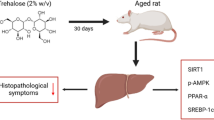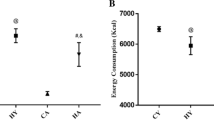Abstract
Background
Dysfunctions in the lipogenic process controlled by the hepatic mTOR/S6K1/SREBP-1c signaling pathway may contribute to the pathogenesis of various chronic diseases. In the present study, we aimed to determine age-related changes in the mTOR/S6K1/SREBP1 pathway in rat liver tissues.
Methods and results
We performed Western Blot analysis to determine age-related changes in the mTOR/S6K1/SREBP1 pathway in Sprague Dawley male rats liver tissues of six different age groups representing neonatal, infant, weaning, puberty, young adult, adult life periods, and Oil Red O staining to evaluate age-related lipid accumulation. We observed an increase in Akt and p-Akt levels with age in compared to the 0-day-old group. Total mTOR and SREBP1 expression increased from the 0-day-old to the 28-day-old group but decreased in the following age groups. p-mTOR and p-S6K1 levels in the 0-day-old group were higher than the other groups. S6K1 expression was lowest in the 0-day-old group and showed changes among the age groups. Lipid accumulation was seen in liver sections taken from the 12-month-old group. mTOR/S6K1/SREBP1 pathway expression showed changes with age during the neonatal-adult life cycle stages in rat liver tissues.
Conclusion
We suggest that understanding the molecular mechanisms age-related changes of lipogenesis function is necessary to contribute to the development of therapeutic approaches.


Similar content being viewed by others
Data availability
Data sharing not applicable to this article as no datasets were generated or analysed during the current study.
Code availability
Not applicable.
References
Bhate A, Parker DJ, Bebee TW et al (2015) ESRP2 controls an adult splicing programme in hepatocytes to support postnatal liver maturation. Nat Commun 6:8768. https://doi.org/10.1038/ncomms9768
C H, (2014) Natural modulators of liver X receptors. J Integr Med 12:76–85. https://doi.org/10.1016/S2095-4964(14)60013-3
Benedict M, Zhang X (2017) Non-alcoholic fatty liver disease: An expanded review. World J Hepatol 9:715. https://doi.org/10.4254/WJH.V9.I16.715
Ipsen DH, Lykkesfeldt J, Tveden-Nyborg P (2018) Molecular mechanisms of hepatic lipid accumulation in non-alcoholic fatty liver disease. Cell Mol Life Sci 75:3313–3327. https://doi.org/10.1007/s00018-018-2860-6
Sanders FWB, Griffin JL (2016) De novo lipogenesis in the liver in health and disease: More than just a shunting yard for glucose. Biol Rev 91:452–468. https://doi.org/10.1111/brv.12178
Düvel K, Yecies JL, Menon S et al (2010) Activation of a metabolic gene regulatory network downstream of mTOR complex 1. Mol Cell 39:171–183. https://doi.org/10.1016/j.molcel.2010.06.022
Owen JL, Zhang Y, Bae S-H et al (2012) Insulin stimulation of SREBP-1c processing in transgenic rat hepatocytes requires p70 S6-kinase. Proc Natl Acad Sci 109:16184–16189. https://doi.org/10.1073/pnas.1213343109
Porstmann T, Santos CR, Griffiths B et al (2008) SREBP activity is regulated by mTORC1 and contributes to Akt-dependent cell growth. Cell Metab 8:224–236. https://doi.org/10.1016/j.cmet.2008.07.007
Shimano H, Sato R (2017) SREBP-regulated lipid metabolism: convergent physiology—divergent pathophysiology. Nat Rev Endocrinol 13:710–730. https://doi.org/10.1038/nrendo.2017.91
Zhou Y, Yu S, Cai C et al (2018) LXRα participates in the mTOR/S6K1/SREBP-1c signaling pathway during sodium palmitate-induced lipogenesis in HepG2 cells. Nutr Metab. https://doi.org/10.1186/s12986-018-0268-9
Li X, Wu JB, Chung LWK, Huang W-C (2015) Anti-cancer efficacy of SREBP inhibitor, alone or in combination with docetaxel, in prostate cancer harboring p53 mutations. Oncotarget 6:41018–41032. https://doi.org/10.18632/oncotarget.5879
Tao T, Su Q, Xu S et al (2019) Down-regulation of PKM2 decreases FASN expression in bladder cancer cells through AKT/mTOR/SREBP-1c axis. J Cell Physiol 234:3088–3104. https://doi.org/10.1002/jcp.27129
Zhang M, Chi X, Qu N, Wang C (2018) Long noncoding RNA lncARSR promotes hepatic lipogenesis via Akt/SREBP-1c pathway and contributes to the pathogenesis of nonalcoholic steatohepatitis. Biochem Biophys Res Commun 499:66–70. https://doi.org/10.1016/j.bbrc.2018.03.127
Conjeevaram Selvakumar PK, Kabbany MN, Lopez R et al (2018) Prevalence of Suspected nonalcoholic fatty liver disease in lean adolescents in the United States. J Pediatr Gastroenterol Nutr 67:75–79. https://doi.org/10.1097/MPG.0000000000001974
Woo Baidal JA, Elbel EE, Lavine JE et al (2018) Associations of early to mid-childhood adiposity with elevated mid-childhood alanine aminotransferase levels in the project viva cohort. J Pediatr 197:121-127.e1. https://doi.org/10.1016/j.jpeds.2018.01.069
Zhang X, Wu M, Liu Z et al (2021) Increasing prevalence of NAFLD/NASH among children, adolescents and young adults from 1990 to 2017: a population-based observational study. BMJ Open 11:e042843. https://doi.org/10.1136/BMJOPEN-2020-042843
Doycheva Iliana, Watt Kymberly D, Alkhouri Naim (2017) Nonalcoholic fatty liver disease in adolescents and young adults: The next frontier in the epidemic. Hepatology 65:2100–2109. https://doi.org/10.1002/HEP.29068
National Research Council, Division on Earth and Life Studies, Institute for Laboratory Animal Research, Committee for the Update of the Guide for the Care and Use of Laboratory Animals (2011) Guide for the Care and Use of Laboratory Animals. National Academies Press, Washington, DC
Lee C (2007) Protein Extraction From Mammalian Tissues. Methods Mol Biol 362:385–389
Adomshick V, Pu Y, Veiga-Lopez A (2020) Automated lipid droplet quantification system for phenotypic analysis of adipocytes using cell profiler. Toxicol Mech Methods 30:378. https://doi.org/10.1080/15376516.2020.1747124
Kwekel JC, Desai VG, Moland CL et al (2010) Age and sex dependent changes in liver gene expression during the life cycle of the rat. BMC Genomics 11:675. https://doi.org/10.1186/1471-2164-11-675
Nguyen P, Valanejad L, Cast A et al (2018) Elimination of age-associated hepatic steatosis and correction of aging phenotype by inhibition of cdk4-C/EBPα-p300 axis. Cell Rep 24:1597–1609. https://doi.org/10.1016/j.celrep.2018.07.014
Sengupta P (2013) The laboratory rat: relating its age with human’s. Int J Prev Med 4:624–630
Hadem I, Sharma R (2015) Age- and tissue-dependent modulation of IGF-1/PI3K/Akt protein expression by dietary restriction in mice. Horm Metab Res 48:201–206. https://doi.org/10.1055/s-0035-1559770
Sarbassov DD, Ali SM, Sabatini DM (2005) Growing roles for the mTOR pathway. Curr Opin Cell Biol 17:596–603. https://doi.org/10.1016/j.ceb.2005.09.009
Petersen Shay K, Hagen TM (2009) Age-associated impairment of Akt phosphorylation in primary rat hepatocytes is remediated by alpha-lipoic acid through PI3 kinase, PTEN, and PP2A. Biogerontology 10:443–456. https://doi.org/10.1007/s10522-008-9187-x
Kennedy BK, Lamming DW (2016) The mechanistic target of rapamycin: the grand conductor of metabolism and aging. Cell Metab 23:990–1003. https://doi.org/10.1016/j.cmet.2016.05.009
Antikainen H, Driscoll M, Haspel G, Dobrowolski R (2017) TOR-mediated regulation of metabolism in aging. Aging Cell 16:1219–1233. https://doi.org/10.1111/acel.12689
Houtkooper RH, Argmann C, Houten SM et al (2011) The metabolic footprint of aging in mice. Sci Rep 1:134. https://doi.org/10.1038/srep00134
Baar EL, Carbajal KA, Ong IM, Lamming DW (2016) Sex- and tissue-specific changes in mTOR signaling with age in C57BL/6J mice. Aging Cell 15:155–166. https://doi.org/10.1111/acel.12425
Sengupta S, Peterson TR, Laplante M et al (2010) mTORC1 controls fasting-induced ketogenesis and its modulation by ageing. Nature 468:1100–1104. https://doi.org/10.1038/nature09584
Yang W, Burkhardt B, Fischer L et al (2015) Age-dependent changes of the antioxidant system in rat livers are accompanied by altered mapk activation and a decline in motor signaling. EXCLI J 14:1273–1290. https://doi.org/10.17179/excli2015-734
Engelking LJ, Cantoria MJ, Xu Y, Liang G (2018) Developmental and extrahepatic physiological functions of SREBP pathway genes in mice. Semin Cell Dev Biol 81:98–109. https://doi.org/10.1016/j.semcdb.2017.07.011
Lee SM, Zhang Y, Tsuchiya H et al (2015) Small heterodimer partner/neuronal PAS domain protein 2 axis regulates the oscillation of liver lipid metabolism. Hepatology 61:497–505. https://doi.org/10.1002/hep.27437
Salamanca A, Bárcena B, Arribas C et al (2015) Aging impairs the hepatic subcellular distribution of ChREBP in response to fasting/feeding in rats: Implications on hepatic steatosis. Exp Gerontol 69:9–19. https://doi.org/10.1016/j.exger.2015.05.009
Wei Q, Zhou B, Yang G et al (2018) JAZF1 ameliorates age and diet-associated hepatic steatosis through SREBP-1c -dependent mechanism. Cell Death Dis 9:859. https://doi.org/10.1038/s41419-018-0923-0
Acknowledgements
This study was supported by the Scientific and Technological Research Council of Turkey (TUBITAK) [Grant Number: 119S221].
Funding
This study was supported by the Scientific and Technological Research Council of Turkey (TUBITAK) [Grant Number: 119S221].
Author information
Authors and Affiliations
Contributions
All authors contributed to the study conception and design. Material preparation, data collection and analysis were performed by MY. The first draft of the manuscript was written by MY and MK. All authors commented on previous versions of the manuscript. The research project and the manuscript was supervised, reviewed, and edited by MK All authors read and approved the final manuscript.
Corresponding author
Ethics declarations
Conflict of interest
The authors declare that there is no conflict of interest.
Ethical approval
Experimental procedures were approved by Yeditepe University Local Ethic Committee. Animals were treated in accordance with Guide for the Care and Use of Laboratory Animals.
Consent to participate
Not applicable.
Consent to publish
Not applicable.
Additional information
Publisher's Note
Springer Nature remains neutral with regard to jurisdictional claims in published maps and institutional affiliations.
Supplementary Information
Below is the link to the electronic supplementary material.
Rights and permissions
About this article
Cite this article
Yalçın, M., Kaçar, M. Investigation of the hepatic mTOR/S6K1/SREBP1 signalling pathway in rats at different ages: from neonates to adults. Mol Biol Rep 48, 7415–7422 (2021). https://doi.org/10.1007/s11033-021-06757-4
Received:
Accepted:
Published:
Issue Date:
DOI: https://doi.org/10.1007/s11033-021-06757-4




